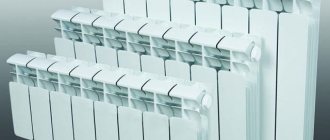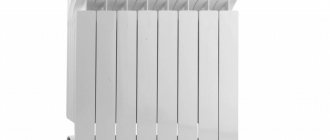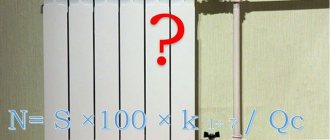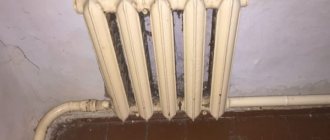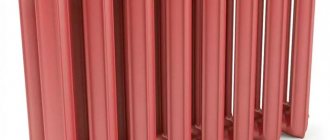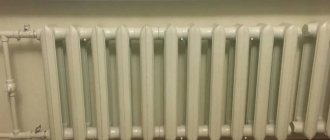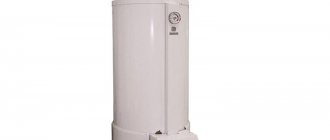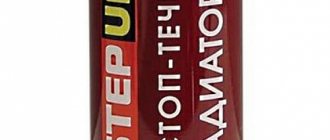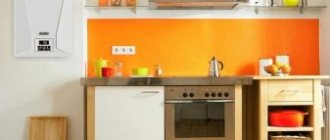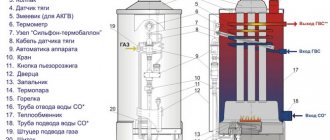Otherwise, some problems may occur during operation of the device. For example, the battery will not warm up evenly. Leaking may also occur. Most often, if the heating radiator does not warm up completely, the reason may be due to improper installation. Therefore, if you are not a specialist and are not confident in your knowledge and abilities, it is better to seek help from professionals. Conner heaters also occupy a leading place among the sales of heating devices on the market. They have good technical parameters. Therefore, there are only positive reviews of Konner cast iron heating radiators. Batteries from this manufacturer are affordable. They are produced in different configurations, with different diameters of inlet pipes and different numbers of sections.
You also need to ensure that the device is in good condition. Cast iron batteries are classic heating devices that have stood the test of time. Of course, today on the market manufacturers offer more modern types of radiators made from other metals. For example, bimetal, steel, aluminum. But still, cast iron batteries do not lose popularity. After all, cast iron heating radiators whose technical characteristics meet quality standards are distinguished by a number of significant advantages. The parameters and appearance of modern models of cast iron appliances have changed somewhat. Therefore, this article will focus specifically on the technical characteristics of this device.
Radiators ms 90 technical specifications
INDUSTRIAL QUALITY TECHNOLOGY
- Catalog
- Contacts
- About company
- Partners
- Delivery
- Reviews
- Calculator
- Services
ROLLED METAL AND METAL PRODUCTS
FOR 14 YEARS WE HAVE SPECIALIZED IN THE SUPPLY OF ROLLED METAL IN A FULL RANGE, AS WELL AS METAL PRODUCTS FOR VARIOUS FIELD OF APPLICATION
POSITIONS IN STOCK
IN MAJOR CITIES OF RUSSIA
SHIPMENTS FROM WAREHOUSE
- Ferrous rolled metal Steel pipes Hot rolled
- Cold rolled
- Electric welded
- Profile square
- Profile rectangular
- Profile galvanized
- Galvanized
- Water and gas pipeline VGP
- Gas lift
- Boiler room
- Cast iron
- Borilnaya
- Asbestos-cement
- Magistralnaya
- Casing
- tubing
- Cracking
- Armature
- Steel sheet
- Woven mesh
- Cast iron hatch
- Steel wire rod
- Stainless steel pipes
- Aluminum Pipe
- Blanks
- Copper pipe
- Brass sheet
- Bronze sheet
- Titanium sheet
- Nickel anode
- Cast iron radiators
- Rope
| Monday | from 8:30 to 18:00 |
| Tuesday | from 8:30 to 18:00 |
| Wednesday | from 8:30 to 18:00 |
| Thursday | from 8:30 to 18:00 |
| Friday | from 8:30 to 17:00 |
| Saturday | Day off |
| Sunday | Day off |
- Calculator
- Cutting services
- Reviews
- Contacts
- Delivery
- About company
- Are you here:
- home
- Shut-off valves
- Cast iron radiators
- Cast iron radiator MS-90 primer 500 GOST 8690-94
If you still have questions or comments about your purchase, please contact our managers at the numbers below.
Telephone numbers for ordering goods in Yekaterinburg
8-(800)
770–08–06
Opening hours in Yekaterinburg
How to purchase rolled metal
Fill out the application form and the manager will contact you during business hours
within
15 minutes
you sign an agreement
and pay the bill
You get it ready
rolled metal at point B
Leave a request for a call back and we will call you back within 15 minutes
Cast iron radiator MS-90-500 (heat output 0.135 kW/section)
Show wholesale prices
| Day | Working hours | Break |
| Monday | 09:00 — 19:00 | |
| Tuesday | 09:00 — 19:00 | |
| Wednesday | 09:00 — 18:00 | |
| Thursday | 09:00 — 19:00 | |
| Friday | 09:00 — 19:00 | |
| Saturday | 10:00 — 16:00 | |
| Sunday | Day off |
* Time specified for the region: Russia, Irkutsk
Technical characteristics of one section
Terms of Use:
operating pressure – 1.2 MPa (12 bar) test pressure – 1.5 MPa (15 bar) coolant temperature – up to 130 °C pH value – from 6.5 to 9
Product description
Cast iron radiators have long established themselves as a simple and practical source of heating. Cast iron radiators MS-90 are reliable and time-tested heating devices, affordable and in no way inferior in quality!
The design of MS-90 cast iron radiators is ideal for Russian heating networks. They are unpretentious to the quality of the coolant, and allow the use of contaminated water, typical of central heating systems in Russia. MS-90 cast iron radiators are distinguished by their high thermal power and compact sectional design. Thick walls and the chemical properties of cast iron give radiators resistance to corrosion, which is important in the summer when the water from the heating system is drained and the radiator is left to rust “dry.” Due to its large mass, cast iron smoothes out temperature fluctuations.
Cast iron heating radiators MS-90 have been used effectively in our country for a long time. Cast iron radiators have become widespread due to their advantages: - high reliability and durability - wide range of applications - long useful life, more than fifty years - ease of maintenance and repair - if one or more sections fail, they can be replaced with new ones .
Transportation and storage
Transportation of radiators is permitted by any type of transport that ensures the safety of the devices from mechanical damage. Radiators are transported in bags. Package contents: 12 seven-section and 1 four-section radiator.
Cast iron radiators should be stored indoors or under cover and protected from moisture and corrosive chemicals.
The supplier is not responsible for transport damage to radiators.
Warranty
Service life – up to 50 years.
The manufacturer guarantees that radiators comply with the mandatory requirements of GOST 8690-94, provided that the consumer complies with the conditions of transportation, storage, installation and operation. If a defect is discovered due to the fault of the manufacturer during the warranty period, the radiator must be replaced by the organization that sold the device.
Specifications:
Radiator type: sectional two-channel. Section length - 78 mm, height - 571 mm, depth -90 mm. Nominal heat flow - 0.130 kW. The capacity of one section is 1.15 l. Nipple hole thread: G 1/4-B.
Radiators MS-90, unlike MS-140, have less weight, the weight of 1 section is 5.6 kg. for MS-140 -7.1-8kg. They are more compact, “thin” and can be easily hidden even under a small window sill. Their heat output is less than that of the MS-140, but due to less heat loss, the general characteristics are close to them.
Table: heat transfer from heating radiators
Calculation for 1 (11 type), 2 (22 type), 3 (33 type) ribs
The heat output of the heating device must be at least 10% of the room area if the ceiling height is less than 3 m. If the ceiling is higher, then another 30% is added. In the room, the radiators are installed under the windows near the outer wall, as a result of which heat is distributed in the most optimal way. Cold air from the windows is blocked by the heat flow from the radiators going up, thereby eliminating the formation of drafts.
Heat transfer of one section according to the manufacturer's passport, W. The selection of a heating device based on the area of the room is a recommendation. The basis for selection was 100 W per 1 m2. According to SNiP, which clearly states that the thermal insulation of a room should be designed so that no more than 100 W of heat is lost per 1 m2. To accurately select the power of the heating device, it is necessary to calculate the heat loss through the building envelope, according to SNiP.
4 sections Du15 Qnu 424 W. Center distance, mmHeat transfer of one section according to the manufacturer's passport, WMaximum operating water pressure, bar
- 4 sections Du15 Qnu=424 W
- 7 sections DN15 Qnu=742 W
- 4 sections DN20 Qnu=424 W
- 7 sections DN20 Qnu=742 W
More.
- 4 sections Du15 Qnu=424 W
- 7 sections DN15 Qnu=742 W
- 4 sections DN20 Qnu=424 W
- 7 sections DN20 Qnu=742 W
Nominal heat flow in accordance with GOST 31311-2005 at dT = 70 oC Radiator length, mm Selection of a heating device according to the room area is a recommendation. The basis for selection was 100 W per 1 m2. According to SNiP, which clearly states that the thermal insulation of a room should be designed so that no more than 100 W of heat is lost per 1 m2. To accurately select the power of the heating device, it is necessary to calculate the heat loss through the enclosing structures, according to SNiP. When entering your personal account, after confirmation by the manager, individual prices for the client are activated on the website.
5. After completion of installation work, pressure testing of the entire water heating system is carried out, based on the results of which a certificate of commissioning of the facility is drawn up. This is done in a standard way - hydraulic tests are carried out under high pressure of 1.5 MPa, exceeding the maximum permitted loads. During the test, the prefabricated structure must not leak or allow air bubbles to pass through.
This is done in a standard way, hydraulic tests are carried out under high pressure of 1.5 MPa, exceeding the maximum permissible loads. The technical parameters of cast iron radiators of the MC 140 brand allow them to be used in steam heating systems of any buildings with virtually no restrictions: in private houses, country cottages, apartments in apartment buildings, administrative offices, public buildings, industrial, warehouse, and retail premises. The equipment is intended for operation in temperate and cold climates (MCC).
Advantages of heating radiators MS 140
- Long service life. This is one of the most durable types of radiators, with a service life of 50 years.
- Reliability. The hundred-year history of this type of radiator in the heating equipment market has confirmed in practice its high reliability.
- Anti-corrosion resistance. Cast iron does not deteriorate over time under the influence of water.
- Undemanding to the quality of the coolant. Cast iron radiators are not sensitive to the quality of the water used inside them. The presence of sand, dirt, high content of salts, acids, alkalis in water does not have a strong effect on the life of cast iron radiators.
- Simplicity of steam heating systems. Cast iron radiators can be used in networks with natural water circulation, without the use of a pump. They are compatible with all types of boilers - solid fuel, gas, pellet, liquid fuel.
- Thermal inertia. Cast iron takes a long time to heat up, accumulates heat well, and cools slowly. In a heating system, this is considered a great advantage, since after the burner is turned off, the cast iron radiator remains warm for a long time, releasing heat into the room.
Disadvantages of heating radiators MS 140
- Sensitivity to water hammer.
- Tendency to slagging of internal surfaces, which over time leads to a decrease in heat transfer.
- Radiators are assembled from separate sections, the joints of which are sealed with rubber gaskets. The lifespan of gaskets is significantly less than cast iron. To avoid leaks, after several years of operation, failed intersection gaskets must be replaced.
- The appearance of such radiators is not sophisticated enough; the surface requires painting.
MS-140 - cast iron classic of “Soviet” times
Cast iron heating radiators MC 140 can be called an undying classic. Despite the abundance of different models of heating devices made of the same cast iron, this one - a Soviet-era “accordion” - is still in demand. It is produced in most countries that were formerly part of the USSR. They are precisely produced in Russia, Ukraine and Belarus. Perhaps production has been established in other countries, but why transport goods far away if there are factories nearby.
Characteristics and Features
The secret of their popularity is simple: in our country, the coolant in centralized heating networks is such that it even dissolves or erases metals. In addition to a huge amount of dissolved chemical elements, it contains sand, particles of rust that have fallen off pipes and radiators, “tears” from welding, bolts forgotten during repairs and a lot of other things that are unknown how they got inside. The only alloy that doesn’t care about all this is cast iron. Stainless steel also does this well, but one can only guess how much such a battery will cost.
MS-140 - an undying classic
And another secret of the MS-140’s popularity is its low price. It has significant differences between different manufacturers, but the approximate cost of one section is about $5 (retail).
Advantages and disadvantages of cast iron radiators
It is clear that a product that has not left the market for many decades has some unique properties. The advantages of cast iron batteries include:
- Low chemical activity, which ensures long service life in our networks. Officially, the warranty period is from 10 to 30 years, and the service life is 50 years or more.
- Low hydraulic resistance. Only radiators of this type can be installed in systems with natural circulation (some also use aluminum and steel tubular ones).
- High temperature of the working environment. No other radiator can withstand temperatures above +130oC. Most of them have a maximum limit of +110oC.
- Low price.
- High heat dissipation. For all other cast iron radiators, this characteristic is in the “disadvantages” section. Only MS-140 and MS-90 have a thermal power of one section comparable to aluminum and bimetallic ones. For MS-140, heat transfer is 160-185 W (depending on the manufacturer), for MS 90 - 130 W.
- They do not corrode when the coolant is drained.MS-140 and MS-90 - difference in section depth
Some properties are a plus under some circumstances, and a minus under others:
- Large thermal inertia. It may take an hour or more until the MS-140 section warms up. And all this time the room does not heat up. But on the other hand, this is good if the heating is turned off, or a conventional solid fuel boiler is used in the system: the heat accumulated by the walls and water maintains the temperature in the room for a long time.
- Large cross-section of channels and collectors. On the one hand, even a bad and dirty coolant will not be able to clog them in just a few years. Therefore, cleaning and washing can be carried out periodically. But due to the large cross-section, more than a liter of coolant “fits” in one section. And it needs to be “driven” through the system and heated, which means extra costs for equipment (a more powerful pump and boiler) and fuel.
“Pure” disadvantages are also present:
- Heavy weight. The weight of one section with an axial distance of 500 mm is from 6 kg to 7.12 kg. And since you usually need from 6 to 14 pieces per room, you can calculate what the mass will be. And you will have to wear it, and also hang it on the wall. This is another drawback: difficult installation. And all because of the same weight.
- Fragility and low working pressure. Not the most pleasant characteristics. Despite their massive size, cast iron products must be handled with care: they may burst upon impact. The same fragility leads to not the highest operating pressure: 9 atm. Pressure testing - 15-16 atm.
- The need for regular coloring. All sections come only primed. They will need to be painted often: once every year or two. Thermal inertia is not always a bad thing...
Application area
As you can see, there are more than serious advantages, but there are also disadvantages. If we summarize everything, we can determine the scope of their use:
- Networks with very low coolant quality (Ph above 9) and a large number of abrasive particles (without mud traps and filters).
- In individual heating when using solid fuel boilers without automation.
- In networks with natural circulation.
Manufacturers, models, technical specifications
MS-140 is produced by the following factories:
- Nizhny Tagil Boiler and Radiator Plant (Russia);
- Minsk Heating Equipment Plant (Belarus);
- Lugansk Foundry and Mechanical Plant (Ukraine);
- JSC "Santekhlit" Bryansk region (Russia);
- LLC "Descartes" Novosibirsk (Russia).
The product has some features and differences; there are models with center distances of 300 mm and 500 mm, as well as a smaller depth option MS-90.
Nizhny Tagil Boiler and Radiator Plant
The plant's products are certified according to the ISO 9001:2008 standard in the Russian Register certification, there is a certificate from the GOST R System and IQNet.
Overall dimensions of MS-140 produced in Nizhny Tagil
Coolant temperature up to +130 oC, operating pressure up to 12 Bar, other technical characteristics are given in the table.
| Model name | Center distance | Dimensions | Section thermal power | Section volume | Section weight | ||
| width | depth | height | |||||
| MS-140-M2-500 | 500 mm | 94 mm | 140 mm | 580 mm | 160 W | 1.45 l | 6.65 kg |
| MS-140M-300 | 300 mm | 104 mm | 140 mm | 388 mm | 117 W | 1.11 l | 5.4 kg |
| MS-90 | 500 mm | 90 mm | 90 mm | 580 mm | 130 W | 1.15 l | 5.475 kg |
Cast iron heating radiators MS 140: technical characteristics
Despite the emergence of many new models of radiators and heating convectors, manufactured using modern technologies using modified materials, cast iron batteries do not lose their widespread popularity today. Due to a number of positive qualities, many owners of apartments and private houses prefer them.
Cast iron heating radiators MS 140 technical characteristics
Cast iron heating radiators MS 140, the technical characteristics of which will be discussed in detail below, have both positive qualities and disadvantages. It should be noted that today these elements of the heating system have been significantly improved - their technical properties have been improved and they have a more aesthetic appearance, although old versions, familiar to everyone from Soviet times, are also sold.
A brief history of the creation of cast iron radiators
Not many people know that cast iron batteries have been used for more than 150 years. The first of them was cast in St. Petersburg, in 1855, at the factory of Franz San Galli, a Russian entrepreneur of German origin. The plant specialized in the development and production of equipment for water supply and heating.
The “father” of the cast iron radiator is considered to be Franz San Galli, a Russian entrepreneur
The first name for a cast iron radiator is “heizkörper”, that is, “hot box”. Such a “box” consisted of vertically installed disks and large-diameter pipes.
Until today, the basic manufacturing technology of cast iron radiators has not undergone any fundamental changes - they are cast from gray cast iron in clay-sand molds.
The outstanding qualities of this heating device have been appreciated by many generations, and in honor of the 150th anniversary of the cast-iron radiator in 2005, a commemorative bas-relief was installed for it at the Samara State District Power Plant.
Monument in honor of the 150th anniversary of the cast iron radiator
The sculptural composition can be called a “folk work”, since it was made by master N. Kuklev based on a photo competition, most of which depicted installed radiators and pets basking on them.
Advantages and disadvantages of cast iron heating radiators
Agree that if a device model has been used for such a long time and is still in demand by consumers, this certainly speaks about its quality and efficiency, and also about the fact that a better option in this “line” has never been invented. However, like any device, cast iron batteries have not only undeniable advantages, but also disadvantages.
Positive qualities of cast iron radiators
- The main advantage of cast iron appliances would be their unconditional reliability. Manufacturers set their service life at 50 years, but, as is known, they can work for a longer time, especially in cases where they are properly maintained regularly.
If we look at history, the oldest battery that functions to this day is a radiator installed 110 years ago in one of the princely houses in Tsarskoe Selo.
- Due to the high heat capacity of cast iron, the design features and massiveness of such heating devices, they are able to retain heat for quite a long time after the heating of the coolant has been turned off.
- Cast iron batteries are installed in both central and autonomous heating systems, as they can withstand pressure up to 9 ÷ 12 atmospheres. This is especially important for devices installed in a central heating system, where water hammer often occurs, which can damage batteries that have thin walls. That is why the cast iron version is so widely used for installation in multi-storey buildings.
- This type of radiator, when assembled well, can easily withstand elevated coolant temperatures, reaching up to 100 ÷ 130 degrees.
- Resistance to coolant of any quality, which also allows the installation of heating devices in a central heating system. The fact is that water, heated at a thermal power plant, is driven through heating mains, and along the way the coolant becomes contaminated from old pipes and enters apartments in the form of an environment that is aggressive to metal, which can cause corrosion of any metal except cast iron.
- The design of the radiator provides wide internal channels, thanks to which blockages rarely occur in the path of the coolant. Wide channels also help maintain the integrity of sections during water hammer.
- Radiant heating. Cast iron radiators are more capable than aluminum or steel ones of transferring heat to surrounding objects using infrared radiation, warming them up. Thus, heated objects transfer heat into the air space of the room, becoming an additional source of heating.
- This type of radiator is dismountable and prefabricated. That is, it is always possible to install a battery of the required thermal power, and, if necessary, make adjustments by adding or removing the required number of sections.
- The affordable price of sections of this type of cast iron batteries, which on average today is 400 ÷ 500 rubles.
The fact that some qualities called positive, from the point of view of other evaluation criteria, may look like shortcomings requires clarification:
— For example, wide channels inside the batteries are good for the free passage of contaminated coolant. But, at the same time, the heating system where such radiators are installed requires a large volume of heated water, which means that a larger amount of fuel will be consumed in the autonomous system, which leads to increased costs.
— High thermal inertia, that is, it takes a long time to warm up the radiator sections, compared to other types of batteries made of thin metal plates. Long warm-up leads to long-term non-stop operation of the boiler, which also means extra fuel costs. However, this negative factor is compensated by the prolonged cooling of the coolant and the batteries themselves when the heating is turned off.
The disadvantages cast iron radiators include the following:
- Large mass of heating devices - the weight of a section with an center distance of 500 mm is from 6 to 7.5 kg. The battery usually consists of 6 ÷ 10 sections, so its total weight will be approximately 36 to 75 kg. If the room has a large area, then sometimes it is necessary to make up a battery from a larger number of sections.
- The heavy weight complicates the installation of the heating system. If the radiators are hung on wall brackets (and in the vast majority of cases this is the case), then you first need to carefully evaluate the ability of the fence to withstand such a load, calculate the strength of the fastenings and install them at a certain depth in the wall, and then hang the heating elements on them.
- Despite the high resistance of cast iron to various negative factors, it is a fairly brittle alloy, so during installation it is necessary to avoid impacts and falling batteries, as sections can crack or burst.
Primed cast iron radiator MS-140
- Cast iron batteries MS-140 of the old model require periodic painting - once at least two or three years. Radiators are sold primed.
- In the opinion of many apartment owners, the appearance of batteries of old models is unaesthetic. This small drawback can be completely corrected with the help of removable screens, which can be selected to suit every taste.
Cast iron radiators MS-140
This brand of cast iron batteries can be called the most used, since they were previously installed in almost every private house or city apartment. The depth of one section of this radiator is 140 mm, the center height is 500 mm, the heat transfer power can reach up to 160 W - depending on the main mode of the boiler room. This type of radiator is marked MS 140-500.
The base material of manufacture is gray cast iron grade SCh-10. For connecting nipples, either ductile cast iron grade KCh - 30-6-F, or steel 08KP (08PS) is used. Gaskets are made of heat-resistant rubber brand TTS or PI. The thread of connecting nipples or plugs is 1¼ inches.
As a rule, radiators are supplied from the factory in assembled batteries of 7 or 4 sections. For construction organizations, delivery is practiced in “packages”, which include 9 seven-section and one four-section battery
They produce several versions of cast iron batteries MS 140:
- In addition to standard two-channel ones, MS 140 - 500 can have fins.
Cast iron radiator with fins
This type of radiator is considered the most effective, since additional fins installed between the two vertical channels of the section, when heated, sharply increase the active heat exchange area. The power of this battery option is higher than that of the “classic” type and can reach up to 195 W.
However, when installing this version of the radiator, you must remember that in order for it to work efficiently, its fins should be periodically cleaned of dirt and dust, otherwise the heat transfer drops by 25 ÷ 40 W.
- Radiator MC 140 ÷ 300
Cast iron radiator MS-140-300
This type of radiator has the same depth of 140 mm, but the height between the axes is only 300 mm, so one section produces about 120 W of thermal energy. This compact battery option is well suited for small rooms, or when the distance between the floor and the window sill is too small to accommodate a taller type of heating device.
Manufacturers of cast iron radiators MS-140
The production of MS-140 cast iron batteries is carried out by factories in several countries, and their products may differ slightly in technical characteristics.
In Russia, radiators are produced by the following enterprises:
- Boiler and Radiator Plant, Nizhny Tagil;
- OJSC "Santekhlit", pos. Lyubokhna Bryansk region;
- LLC "Descartes", Novosibirsk.
In the Republic of Belarus, the production of radiators is carried out by the heating equipment plant in Minsk.
In addition, cast iron batteries produced at the foundry and mechanical plant in Lugansk are presented on the Russian market.
MS-140 radiators with and without fins, and, for comparison, MS-90 radiator
In addition to the MS 140 radiators, these enterprises produce another variety that has a shallower depth - it is labeled MS-90.
Boiler and Radiator Plant, Nizhny Tagil
The plant produces products according to the ISO 9001:2008 standard in the “Russian Register” certification; they also use a certificate from the GOST R and IQNet systems.
Drawing of radiator MS-140 M2-500
The batteries are designed for coolant temperatures of up to 125-130 degrees and for operating pressures of no more than 12 atm. The main characteristics are presented in the table:
| Radiator model | Distance between axles (mm) | Radiator dimensions (mm) | Section thermal power (W) | Section volume (l) | Section weight (kg) | ||
| section width | depth | height | |||||
| MS-140-M2-500 | 500 | 94 | 140 | 580 | 160 | 1.45 | 6.65 |
| MS-140M-300 | 300 | 104 | 140 | 388 | 117 | 1.11 | 5.4 |
| MS-90 | 500 | 90 | 90 | 580 | 130 | 1.15 | 5.48 |
OJSC "Santekhlit", pos. Lyubohna Bryansk region
This manufacturer produces batteries marked MS-140; MS-100 and MS-85.
Radiators meet the following parameters:
— working pressure for MS-140÷ 9 atm., MS-100 and 85 ÷ 12 atm.;
— coolant temperature — up to 130 degrees.
| Radiator model | Distance between axles (mm) | Radiator dimensions (mm) | Section thermal power (W) | Section volume (l) | Section weight (kg) | ||
| section width | depth | height | |||||
| MS-140M-500-0.9 | 500 | 93 | 140 | 588 | 160 | 1.45 | 7.1 |
| MS-140-300-0.9 | 300 | 93 | 140 | 388 | 120 | 1.11 | 6.1 |
| MS-110-500-1.2 | 500 | 82 | 110 | 588 | 125 | 0.85 | 5.6 |
| MS-110-300-1.2 | 300 | 82 | 100 | 381.4 | 79 | 0.63 | 4.45 |
| MS-85-500 | 500 | 76 | 85 | 581.4 | 115 | 1 | 4.45 |
Drawing of radiator MS-140-300
LLC "Descartes", Novosibirsk
Novosibirsk manufacturers produce cast iron batteries designed for a working pressure of 9 atm. and coolant temperature up to 130 degrees.
| Radiator model | Distance between axles (mm) | Radiator dimensions (mm) | Section thermal power (W) | Section volume (l) | Section weight (kg) | ||
| section width | depth | height | |||||
| MS-140/500 | 500 | 93 | 140 | 588 | 160 | 1.45 | 7.1 |
| MS-140/300 | 300 | 93 | 140 | 388 | 120 | 1.11 | 6.1 |
| MS-90/500 | 500 | 71 | 90 | 581 | 130 | 1.45 | 6.5 |
Products of the Minsk Heating Equipment Plant
This company produces cast iron batteries marked MS-140÷500, as well as modified three-channel BZ-140÷300.
An interesting model produced by the Minsk plant
The model range of this company, in addition, includes both hanging versions of radiators and those installed on the floor, which have special stands for this purpose. By purchasing such models, you can get rid of the problems associated with drilling walls, installing brackets and hanging the batteries themselves.
| Radiator model | Distance between axles (mm) | Radiator dimensions (mm) | Section thermal power (W) | Section volume (l) | Section weight (kg) | ||
| section width | depth | height | |||||
| MS-140M | 500 | 108 | 140 | 588 | 160 | 1.45 | 6.7 |
| BZ-140-300 | 300 | 98 | 140 | 376 | 120 | 1.27 | 5.4 |
The plant's designers also worked on the appearance of the radiators. Therefore, this manufacturer’s product range includes models made in a retro style, on the surface of which relief designs are placed.
You can choose models with a relief molded pattern
In addition, batteries are produced that are designed for modern interiors - with flat front plates. These models are even somewhat reminiscent of aluminum or bimetallic radiators in design.
It should be noted that the products of this Belarusian enterprise are of high quality and have earned the best customer reviews.
Foundry-mechanical plant Lugansk
This plant produces radiators marked MS-140, MS-100 and RD-100; they are designed for operating pressures up to 12 atm. and temperatures up to 130 degrees.
| Radiator model | Distance between axles (mm) | Radiator dimensions (mm) | Section thermal power (W) | Section volume (l) | Section weight (kg) | ||
| section width | depth | height | |||||
| MS-140M4-500-0.9 | 500 | 102 | 140 | 588 | 184 | 1.33 | 6.74 |
| MS-140 M1-300-0.9 | 300 | 102 | 140 | 388 | 120 | 1 | 5.5 |
| MS-100 M1 3KP 500 | 500 | 63 | 100 | 570 | 135 | 0.7 | 5.4 |
| MS-1003KP 300-1.2 | 300 | 63 | 100 | 372 | 95 | 0.55 | 3.23 |
| RD- 100 500 -1.2 | 500 | 60 | 100 | 585 | 120 | 0.8 | 4.6 |
In addition to classic cast-iron radiators, the manufacturer produces batteries for modern interiors, which do not require painting, as they have a high-quality enamel coating. This table shows their characteristics and markings - RD-100 500÷1.2.
Nuances of installing cast iron batteries
As everyone knows, any type of heating device is mounted under a window opening. According to experts, this is the optimal area for blocking cold air coming from the window, since the heat rising upward from the radiator creates a kind of curtain.
For a cast iron battery to work effectively, it must be moved away from the wall by at least 40 ÷ 50 mm, raised from the floor by 70 ÷ 100 mm and located 50 mm below the window sill.
To prevent some of the heat from being lost to warming up the cold wall, it is recommended to secure foil insulation behind the radiator, turning its aluminum covering towards the room. Thus, this material will reflect heat towards the room, enhancing the heat transfer effect.
Foil screen on the wall behind the radiator
Since cast iron batteries are very heavy, it is very important to prepare reliable fastenings for them if the devices will be hung on the wall. The brackets must be located every four ÷ five sections of the radiator and recessed into the wall by at least 130 ÷ 140 mm.
To do this, holes are drilled in a stone or concrete wall into which the brackets are mounted on a concrete mortar. A hole with a slightly smaller diameter than the thickness of the bracket is drilled in the wooden fence, then it is carefully driven or screwed into the wall.
Simple hammer-in bracket for cast iron radiator canopy
It is very important to correctly mark the wall and determine the location of the brackets. The radiator must be located exactly horizontally, so the first thing to do is to draw a level line for the brackets, according to the dimensions previously taken from the heater. To avoid mistakes, you can make an exact template from cardboard, on which you can mark the location of the sections and the locations of the fasteners.
Prices for cast iron radiators from different manufacturers
cast iron radiator
Disassembling and assembling a cast iron radiator
For long-term operation of radiators and for their high-quality functioning, it is sometimes necessary to carry out preventive measures to clean individual sections. To do this, you will have to disassemble the radiator or its individual parts.
First of all, you need to become more familiar with the design of the sections connecting.
Interconnection diagram of cast iron radiator sections
1 – housing of the cast iron section of the radiator.
2 – connecting nipple.
3 – end plug.
4 – shows the protrusions on the inner surface of the nipple, for which the working part of the nipple wrench is engaged (item 5)
The main elements required for installing the sections into a single battery:
What is needed to assemble sections into a battery
a – nipple. It is a cast iron or steel cylinder. There are two 1¼-inch threaded sections cut on both sides of the outside. The direction of the threads is the opposite. Similarly, on cast iron sections, left-hand and right-hand threads are cut on opposite sides. Thus, when the nipple is rotated with a wrench in one direction, the nipple is simultaneously screwed into both sections (when dismantled, it is unscrewed, respectively). The figure shows the ribs for gripping the nipple with the working head of the wrench.
b – rubber or paronite gaskets that are installed between sections and under plugs.
c – blind plug. Depending on the installation location, it may have either a left-handed or right-handed thread.
g – passage plug. External thread - the same as on a blind plug, left or right. Internal - right, used for packing the supply or return pipe or fitting.
The work of disassembling the radiator is carried out step by step in the following order:
- If it is necessary to carry out work on radiators connected to the central heating system, then the first thing to do is shut off the coolant supply and then drain the water from the radiators located in the apartment.
In an autonomous heating system, you just need to free the pipes and radiators from the coolant contained in them.
- Next, using a wrench of the required size, the fittings are unscrewed on both sides of the radiator, and it is removed from the brackets. Place the device on a previously prepared sheet of plywood so as not to damage or stain the floor covering.
- The next step is to unscrew the blind side plugs from the battery.
- Then, a radiator key of the required size is inserted into the opened side hole of the battery and turned - for this, a crossbar can be welded to the rod. If not, then turn it with a gas wrench. This is how the nipple connecting the sections is unscrewed. Work must be carried out in parallel with the upper and lower nipple.
Unscrewing the nipple
- In order not to make a mistake with the location of the required nipple, you should estimate in advance the depth of insertion of the key into the battery and make a corresponding mark on the rod.
Many craftsmen use convenient wrenches that have a movable clutch. It not only clearly positions the working head of the wrench on the desired nipple, but also centers the rod, preventing it from skewing when forces are applied during unwinding or assembly.
- Unfortunately, it also happens that if the batteries have not been disassembled for a long time, then the protrusions in the nipple intended for the key are “eaten up” by corrosion. The key turns, and it is impossible to disassemble the battery in the normal way. In this case, you have to resort to drastic measures - the nipple between the sections is very carefully cut along the gasket line with a grinder. Then its threaded parts are heated with a blowtorch and each half of the nipple is unscrewed separately.
- The battery is reassembled in the reverse order. Naturally, the gaskets should be changed. It is worth immediately assessing the safety of the nipples - it may be advisable to replace them with new ones.
Video: dismantling and assembling a cast iron battery
Calculation of the required number of sections of a cast iron battery
The simplest method for determining the required number of sections for heating a room is to take into account only the area of the room.
With great simplification, it is believed that heating 1 m² of area on average requires 100 W of thermal energy. Knowing the area of the room, it needs to be multiplied by 100 and then divided by the thermal power of the radiator model.
For example, a room has an area of 16 m², and a radiator model MS-140-M2-500 is purchased, each section of which has a thermal power of 160 W. In this case, the calculation is made as follows:
- 16 m² × 100 W = 1600 W – heat will be required to heat this room.
- 1600 W : 160 W = 10 pcs. - this is the number of sections required.
If the calculation results in a non-integer number, it is rounded up to a whole number.
However, this technique is overly simplified and does not take into account many criteria.
To make a more in-depth calculation of the required number of sections, you need to take into account many parameters - the level of winter temperatures in the region, the quality and material of the windows, their number in the room and the total area, the degree of wall insulation, and more. Even the connection diagram of radiators and their location in the room matter. This calculation is usually carried out by specialists, and it is not easy to cope with it yourself.
However, our reader is given this opportunity - at his service is a special calculator, which takes into account most of the factors affecting the size of the heating radiator. Just provide the requested information and get the desired result.
Calculator for calculating a cast iron battery
Go to calculations
Although cast iron batteries have the same MS-140 marking, they may have slightly different characteristics, since they are produced according to industry standards of the countries in which they are produced. However, it should be noted that this fact rather plays into the hands of the consumer, since he has the opportunity to choose the appropriate option, especially since some of the parameters vary quite significantly. Learn how to heat a house without gas inexpensively on our website.
You might be interested in information on how to choose an electric boiler
Russian (Soviet) cast iron radiators
Most Russian manufacturers make cast iron batteries of a classic look. They were developed back in the USSR and turned out to be quite successful. There are two main classifications - MS and WC. Outwardly, they are practically the same, but have different characteristics.
Weight of the radiator section ChM1, ChM2, ChM3
Without water
- World Championship 1-70-300 – 3.3;
- World Championship 1-70-500 – 4.8;
- World Championship2-100-300 – 4.5;
- World Championship2-100-500 – 6.3;
- ChM3-120-300 – 4.8;
- World Championship3-120-500 – 7.0.
With water
- World Championship 1-70-300 – 3.95;
- World Championship 1-70-500 – 5.7;
- World Championship2-100-300 – 5.2;
- World Championship2-100-500 – 7.25;
- World Championship3-120-300 – 5.75;
- World Championship3-120-500 – 8.4.
ChM radiators are produced in three versions - single-channel (ChM1), two-channel (ChM2) and three-channel (ChM3). The size and number of channels directly affects the weight of one section.
Weight of 1 section of cast iron radiator series MS 90, 100, 140
Without water
- MS-90/500 – 6.5;
- MS-100/500 – 4.9;
- MS-140/300 – 5.7;
- MS-140/500 – 7.1.
With water
- MS-90/500 – 7.4-7.7;
- MS-100/500 – 5.8-6.1;
- MS-140/300 – 6.5-7;
- MS-140/500 – 8.4-8.9.
Model designations indicate the dimensions of the MC series radiators. The first number is the depth, the second is the height in millimeters. We also note that each manufacturer has its own configurations and section design. For example, the weight of one section of a Soviet cast iron battery MS-90 with a height of 500 mm can fluctuate between 6.3-6.7 kg.
MS 140
The classic and most common radiator is installed in many apartments in our country, as well as in many countries of the post-Soviet space. Section width 140 mm, height (between supply pipes) 500 mm. Additional marking MC 140 – 500. The power of 1 section of this radiator is 175 W of thermal energy.
However, there are many variations of this radiator
MS 140 – 500 with fins (collector)
The most energy-efficient version of the MC 140 radiator. The thing is that additional cast-iron fins are installed between the sections, which also provide additional heating to the room. The power of such a radiator is 195 W of thermal energy (which is 20 W more than the classic MC 140). However, such radiators have a significant disadvantage: you need to monitor the frequency of these fins; if they become clogged (with dust, for example), then the thermal efficiency drops by 30 - 40 W!
MC 140 – 300
As the name implies, this radiator has a width of the same 140 mm, but a height of only 300 mm. This is a compact type of radiator. The power of one section is only 120 W of thermal energy.
Foreign cast iron radiators
Foreign-made cast iron batteries are made in modern or retro style. The latter have more weight due to inlay and artistic elements. As a rule, they can be installed on the floor.
Viadrus Termo (Czech Republic)
Without water
- 500/95 – 4.35;
- 500/130 – 5,35;
- 623/95 – 5,1;
- 623/130 – 6,45;
- 813/95 – 6,7;
- 813/130 – 8,8.
With water
- 500/95 – 4.95;
- 500/130 – 6,15;
- 623/95 – 5,9;
- 623/130 – 7,45;
- 813/95 – 7,7;
- 813/130 – 10,1.
Carron (England)
- The Chelsea 675/67 – 13.3;
- The Daisy – 11.3;
- The Orleans - 17.3;
- The Rococco – 16.6;
- The Verona – 14.3.
Carron Chelsea cast iron radiator.
Demrad Ridem (Türkiye)
- 2/813 – 5,15;
- 3/350 – 3,37;
- 3/500 – 4,8;
- 3/623 – 5,5;
- 3/813 – 7,05;
- 4/500 – 6,15;
- 4/623 – 7,25;
- 4/813 – 8,95.
New cast iron radiators
It is not uncommon now to see modern cast iron radiators, produced by both imported companies and our domestic ones. They look somewhat similar to aluminum radiators. The power of 1 section of such a radiator ranges from 150 to 220 W, much depends on the size of the radiator.
And that’s all, I think I gave you the layout of the usual cast iron radiators. Of course, the power may vary a little from manufacturer to manufacturer, but approximately the power remains within these limits.
By the way, you can read how to decorate a cast iron battery as “RETRO” , it turns out very beautiful and inexpensive
